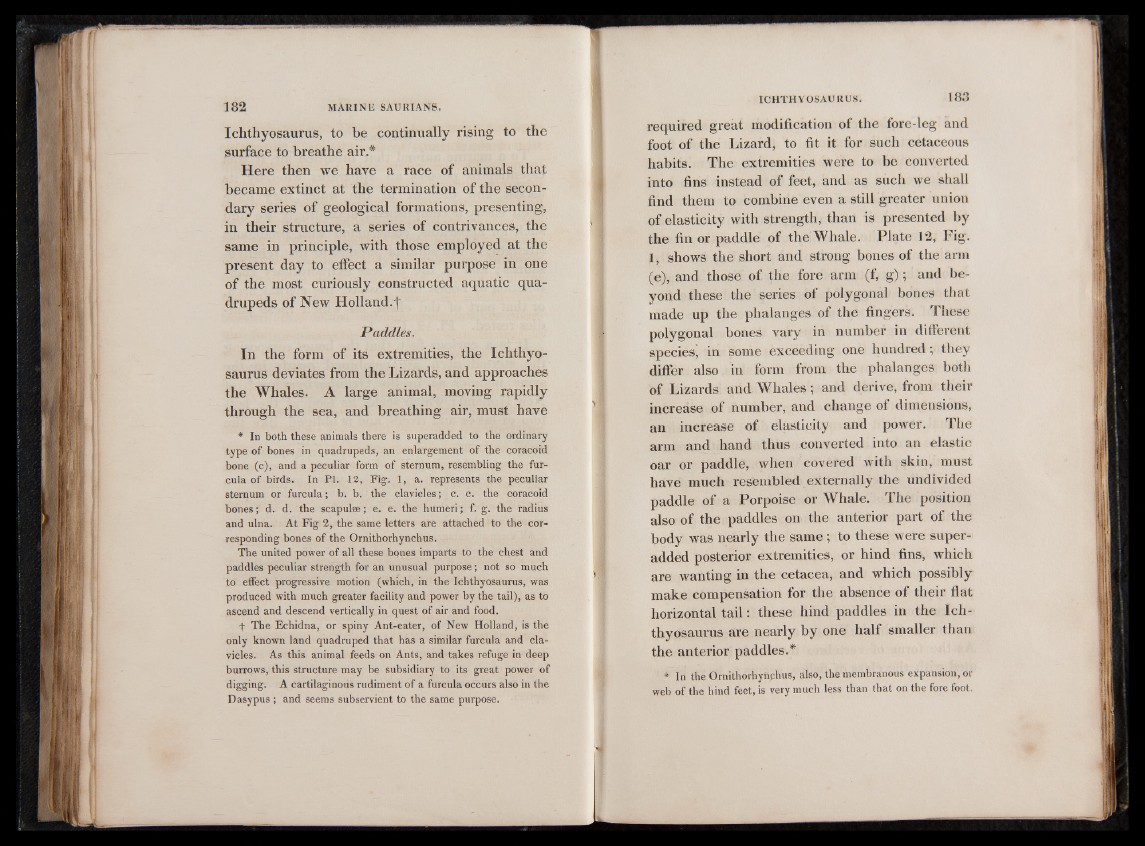
Ichthyosaurus, to be continually rising to the
surface to breathe air.#
Here then we have a race of animals that
became extinct at the termination of the secondary
series of geological formations, presenting,
in their structure, a series of contrivances, the
same in principle, with those employed at the
present day to effect a similar purpose in one
of the most curiously constructed aquatic quadrupeds
of New Holland.|
Paddles.
In the form of its extremities, the Ichthyosaurus
deviates from the Lizards, and approaches
the Whales. A large animal, moving rapidly
through the sea, and breathing air, must have
* In both these animals there is superadded to the ordinary
type of bones in quadrupeds, an enlargement of the coracoid
bone (c), and a peculiar form of sternum, resembling the fur-
cula of birds. In PI. 12, Fig. 1, a. represents the peculiar
sternum or furcula; b. b. the clavicles; c. c. the coracoid
bones; d. d. the scapulae; e. e. the humeri; f. g. the radius
and ulna. At Fig 2, the same letters are attached to the corresponding
bones of the Ornithorhynchus.
The united power of all these bones imparts to the chest and
paddles peculiar strength for an unusual purpose; not so much
to effect progressive motion (which, in the Ichthyosaurus, was
produced with much greater facility and power by the tail), as to
ascend and descend vertically in quest of air and food.
f The Echidna, or spiny Ant-eater, of New Holland, is the
only known land quadruped that has a similar furcula and clavicles.
As this animal feeds on Ants, and takes refuge in deep
burrows, this structure may be subsidiary to its great power of
digging. A cartilaginous rudiment of a furcula occurs also in the
Dasypus ; and seems subservient to the same purpose.
required great modification of the fore-leg and
foot of the Lizard, to fit it for such cetaceous
habits. The extremities were to be converted
into fins instead of feet, and as such we shall
find them to combine even a still greater union
of elasticity with strength, than is presented by
the fin or paddle of the Whale. Plate 12, Fig.
1, shows the short and strong bones of the arm
(e), and those of the fore arm (f, g) ; and beyond
these the series of polygonal bones that
made up the phalanges of the fingers. These
polygonal bones vary in number in different
species, in some exceeding one hundred; they
differ also in form from the phalanges both
of Lizards and Whales; and derive, from their
increase of number, and change of dimensions,
an increase of elasticity and power. The
arm and hand thus converted into an elastic
oar or paddle, when covered with skin, must
have much resembled externally the undivided
paddle of a Porpoise or Whale. The position
also of the paddles on the anterior part of the
body was nearly the same; to these were super-
added posterior extremities, or hind fins, which
are wanting in the cetacea, and which possibly
make compensation for the absence of their flat
horizontal ta il: these hind paddles in the Ichthyosaurus
are nearly by one half smaller than
the anterior paddles.*
* In the Ornithorhy&phus, also, the membranous expansion, or
web of the hind feet, is very much less than that on the fore foot.